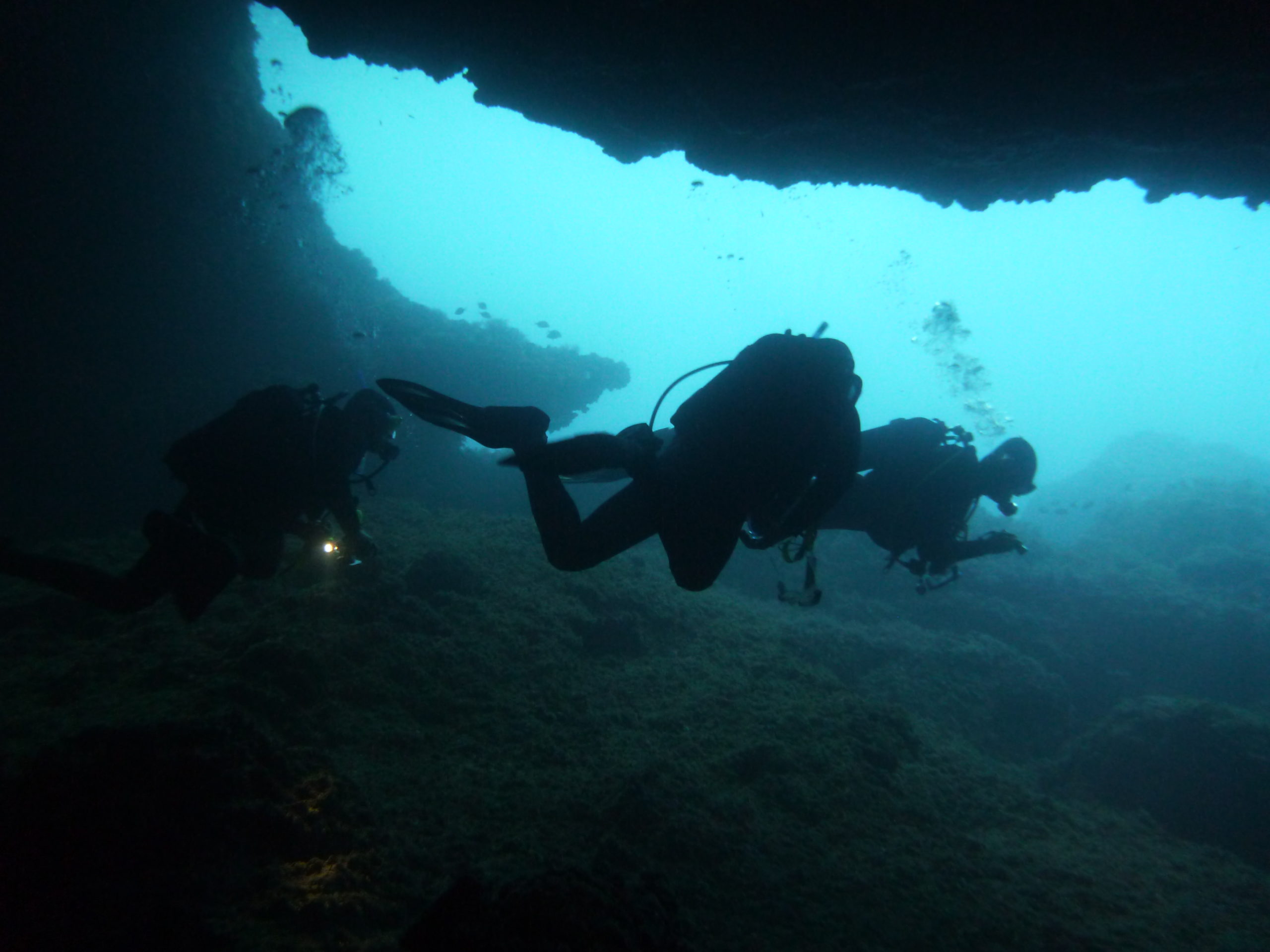Cave Diving: A comprehensive Guide To The Extreme Sport

Are you drawn to the thrill and challenge of untouched and unexplored underwater environments? If yes, then cave diving is what you will love.
Cave diving refers to diving underwater with an overhead environment where you don’t directly access the light, surface, or open air. A diving expedition in caves can be easily a round trip of many miles underwater. If you go on a professional cave diving expedition, you might discover some ancient rock formations. You may also discover some places which any human might have never touched.
In the article, we will explain all the aspects of cave diving, including diving gear; what is a sump? What is a spring? And more.
What Is The Difference Between A Cave Diver And Cavern Diver?
Before we move on further and explore the aspects of cave diving, let’s first understand the difference between cave and cavern divers.
Cavern Diving
When we talk about the difference between the two, we can essay there are several which separate them from each other. In cavern diving, the diving usually takes place near the mouth of the cave. While at this place of scuba diving, there are overhead obstacles in the place, and the environment is still illuminated with natural sunlight.
According to the National Speleological Society’s definition of the cave diving sections, cavern diving and cave diving are different. Cavern diving refers to scuba diving in an area that receives sunlight directly and is not deep than 70 feet. It should also be within 130 linear feet from the entrance of the cave. In short, cavern diving is a scuba diving activity undertaken during the daytime near cave openings.
Cave Diving
On the other hand, cave diving is different as divers can dive deep and go underwater for miles. They can also go in areas with no access to natural light or areas with limited visibility in the water.
Another difference between the two is that both of these are extreme sports, but cave diving needs special qualifications. This qualification is for the top 1% of the divers only as it is tough and extreme. The diving gear which the divers use in the two versions is also different. There are also special terms for murky and clear water which the cave divers use – sump and spring.
These are some of the major differences between cavern and cave diving.
What Is A Spring?
Have you seen those eye-catching diving shots which are printed on National Geographic? Well, those are mostly from the spring water areas of diving.
In the spring dives, the caves’ surrounding water is generally clear, glowing in the subterranean ventures. One example is the famous Florida Spring; here, all you need to do is maintain your body’s buoyancy and just swim with water flow. However, you need to keep your hands on the caves guideline.
What Is A Sump?
A sump diving expedition is different from spring cave diving as it needs the divers to go through dry and wet cave networks.
In the sumo, visibility inside the water is low, and you need to surface inside the small pockets of the cave. One famous example of sump diving is one that caught the attraction of the world in 2018 – the Thai Cave Rescue. In this rescue mission, a mission was undertaken to save a soccer team named wild boars that were trapped inside the Tham Luang Cave System.
During this rescue mission, tragically, Saman Kunan, a former Navy Seal of the Thai Navy, died due to asphyxiation. He died while trying to deliver oxygen between the chambers. Although a diving buddy accompanied him, he can’t be revived even after CPR. In the wake of this tragedy, the Thai Navy has also included cave diving into its training programs. This will help them to do the rescue and other operations in the future when their caves are flooded during the monsoon. It will also help them reduce dependence on international experts.
Don’t underestimate cave driving is an extremely dangerous sports activity to undertake. You need experience, temperament, and skill to safely undertake it and navigate through dangerous situations.
Cave Diving Dangers
No matter what type of diving you undertake, it comes with its own set of risks. This is the reason why in the introductory course for the certification program, divers are taught to manage stressful conditions. They are taught this for the Open Water Certification, which is a very important scuba diving certification specifically for cave divers. But when going scuba diving in the open waters, you always know that swimming upwards will take you to the safety of the surface.
While in cave diving, sometimes, even if you know which way is up, it doesn’t matter as stress may be heightened. The fact that any of the paths can be the way to safety stress levels may shoot up. This is the reason that before going for cave diving, the divers have to master numerous drills.
The drills include the following:
- What to do in a situation where your tank’s air runs out.
- How to address the failure of various diving equipment like a diving mask or helmet.
- What to do in a situation if your dive buddy gets entangled in the guideline or line.
- How to deal with the situation if you lose your dive buddy inside the cave.
- What you can do if you lose the line which connects you to the exit of the cave.
As the list above shows, there can be extreme situations during cave diving. But the good thing is that scuba diving certification specially designed for cave diving trains you for all such situations. The certification programs also include blinding of the diving mask to train the divers to navigate using the guideline without seeing in the water.
What Skills And Certificates Do A Person Need To Become A Cave Diver?
So, are you determined to become a cave diver? Well, if yes, then before setting off on the first adventure, you will need to tick off the following steps:
- In the first step, you will need to complete an Open Water Certification Course on an advanced level. It allows you to dive up to a range of 130 feet.
- The next thing in the certification is the specialist course. In it, you need to experience cavern diving with low light and overhead environmental conditions.
- In the final step, you will be needed to complete a course in night diving. This is essential as caves are not abundant with direct sunlight usually.
Once you have ticked off the above-needed certifications, you can embark on an adventure of a cave diving course. During the cave diving education, you will come across various types of underwater caves in the next step.
Types of Caves
There are four types of caves in which you can go diving. These are:
Sea Or Littoral Caves
These caves are one of the favorites among less experienced cave diving enthusiasts. You can mostly find these caves in the coastal regions as they are made by the waves. The good thing about them is that they mostly have clear water and don’t need you to go miles. They are generally not very long or confusing.
Example: Great Lakes in New England and California.
Coral Caves
Like the name suggests, these are large formations of the coral reefs which grow on extensive levels. During this growth, they create closed-off underwater caves. These underwater caves are normally home to sharks, fish, and other sea life.
Lava Tubes
The lava tube underwater caves are formed due to the volcanic activities in the region. When the melted lava flows down to the seawater, it cools down, and the surface of lava hardens, thus forming lava tubes. Inside these tubes, the lava is still flowing. Some of the most popular destinations for lava tube cave diving include Hawaii.
Solution Caves
These types of caves are formed over the eons. The water which contains carbonic acid slowly seeps through the surface of limestone, which results in the dissolving of the rock at lower levels. This creates a cave structure at the bottom. One of the finest examples of such cave structures is the Florida network of caves.
Various Cave Diving Techniques
It’s all well and good to have all types of scuba diving and cave diving certificates along with knowledge of the caves you are going to explore, but you need buoyancy control and perfection in techniques at the instructor level for proper cave diving. Some of the propulsion techniques which you need to master are:
- Flutter kicks
- Frog kicks
- Helicopter turns
- Back kicks
These propulsion techniques are vital for cave diving as the improper technique may result in stirring up the silt on the floor of the cave. This may, in turn, result in ruining the visibility, although such kicks are not a problem in open water.
Once you have all the certifications and qualifications which are needed for cave diving, the next thing you will need is the diving gear. You will need a proper diving helmet, diving suit, and diving mask to avoid any problems in your expedition.
Cave Diving Gear
Like we said, cave diving is a kind of highly specialized activity. For cavern diving, you will need to use gear with a single tank that has K-valves. You will also need to use a single regulator.
However, you will need to use diving gear that offers 2 different valves for on and off for cave diving. It should also have first-stage regulators. This is essential as if inside a cave, due to any rock or formation your O-ring ruptures or the regulator starts free-flowing, you have the option to shut it off. The option lets you use the second tank for supply in such cases.
Other than this, all the scuba diving gear need reconfiguration for ensuring that the risk of silt kickup and entanglement is reduced. So, inflator hoses, all gauges, and the regulators are stowed or fitted on the diving suit closely and tightly. The flapping fin straps also need tapping down so that they don’t create any problems. One change in the diving mask is the removal of snorkels from it. This is done as there is no option of reaching the surface down in a cave, and secondly, it may get stuck in a formation or ceiling of the cave.
In the cave, diving entanglement is the biggest risk for divers, and thus everything needs to be strapped down on the diving suit.
Reel
One Of the most crucial pieces of equipment for cave diving is the reel. This reel line is laid down as the divers explore the cave more and more. Without the reel, there is nothing to guide the divers to the mouth of the cave. This becomes essential as eleven in the clear water conditions at lousy kick may lead to ruining of visibility.
This is why a cave divers rope is known to be literally their lifeline.
Wetsuit
A wetsuit is an essential part of the cave diving gear as even in tropical climates, the temperatures inside the caves are low. This is because there is no direct sunlight inside the caves. Another thing you need to know is that gloves are not recommended in cave diving. This is because, inside the caves, the divers need to rely on their touch senses in the low visibility conditions.
Best Cave Diving Lights
The caves are dark, and the visibility is low. Thus for proper navigation, it is essential to have a set of two lights: primary and backup light. Most of the divers prefer a canister light as their primary light and the various types of diving helmet-mounted lights or those attached to their BC.
Some of the best lights you can get for cave diving are SL4 eELD and Aqualite Pro2. These two lights are compact and lightweight. Both of the lights offer narrow and bright beams of light, making it easy to look down even in a long passageway.
Final Words
Cave diving is an extreme activity that is for people who love extreme sports and like to test their limits and push their abilities.
The cave diving is also a genuine exploration activity that you can undertake as the world is running low on the adventure’s frontiers. All you need to know is some skills and have some certifications. Of course, you also need to be highly careful down there.




